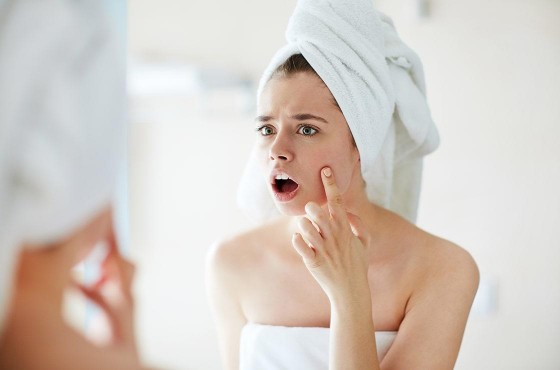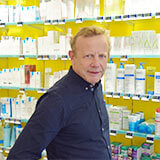Adapt your beauty regime and overcome acne!
Written by Paul Musset, Doctor in Pharmacy | published on | updated on 13/04/2023

Acne is usually associated with puberty. That’s because this skin complaint generally arises during the teenage years as young people move towards adulthood. But, does acne only affect the young? What causes the skin to breakout in spots? Which skincare treatments should you choose if you have facial acne?
What is acne?
The mechanism
Acne is a dermatological condition which targets the hair follicles. The hair follicle is home to the sebaceous glands, where sebum is produced. Sebum is an oily substance essential for maintaining healthy skin.
Acne typically presents as a spot around the hair follicle. Three biological factors are responsible for the appearance of these spots:
- An overproduction of sebum in the follicle;
- A blockage preventing sebum from dispersing naturally and carry out its lubricating, protective function;
- Bacterial growth which is worsened by excess sebum.
These three phenomena lead to the development of two types of spots:
- Retentional acne: simple black or whiteheads (blackheads or micro-cysts)
- Inflammatory acne: resulting from an outbreak of micro-cysts, causing inflamed red lesions.
Papules or pustules: what is the difference?
Acne is characterised by these two types of lesion. - A papule is a raised red bump. - A pustule is an inflamed papule containing white pus.
Who is affected?
Acne can affect anyone at any point in their lives. Hormonal changes make pubescent skin especially prone to acne.
However, it can affect adults too. Women are more commonly affected than man and currently make up around 80% of the adults with acne. Moreover, 4 in 10 women suffer from adult acne, even though they did not have the condition during puberty.
The different causes and types of acne
Factors that can trigger acne: perception and reality
Genetics is the key
Genetics is one of the main risk factors which trigger acne, with 70% of patients reporting a family history of the condition.
The spots are not infectious
This popular misconception is due to the role played by bacteria in the mechanism that causes acne. It is important to differentiate here between the mechanism and the cause. Bacteria does not cause spots to appear; instead, bacteria are naturally present on our skin. The combination of excess sebum and its obstructed flow encourages the abnormal growth of bacteria.
The main culprits of acne: sex hormones
The primary male hormone, better known as testosterone, plays a decisive role in triggering acne. This is because it is responsible for the development of the sebaceous glands. These mature at puberty, which is one of the stages of life during which testosterone is at its highest. This temporary over-production of hormones triggers seborrhoea (excess sebum), which itself encourages the growth of bacteria if there are blockages.
The role of diet
Studies have demonstrated a causal relationship between a diet rich in dairy products and simple carbohydrates and the triggering of acne.
The sun: not a genuine cure for acne
The sun’s ultra-violet rays often activate the skin’s melanin production, producing a suntan. The drying effect will reduce the acne. However, it is just a brief interlude, as during this phase, it is also typical for a protective barrier which thickens the skin to form. This thickened layer will later encourage sebum retention, thereby triggering the acne cycle again to an even greater extent (commonly known as an acne flare-up).
Stress
Findings have shown that sufferers experience more acne during examination periods or in the run-up to an important professional presentation, indicating that stress can also trigger acne.
What are the different types of acne?
Juvenile acne
80 % of teenagers will go through a phase of acne during puberty. Genetic and hormonal factors combined are the main cause of teenage acne. Juvenile acne mainly affects the face.
Baby acne
This affects 20 % of new-borns, primarily on the face. It occasionally appears on the chest, shoulders and the top of the back. The assumption is that baby acne is caused by the production of maternal androgens that stimulate the sebaceous glands. Baby acne disappears of its own accord during the first few months of life.
Acne conglobata or back acne
This type of acne mainly affects the face, although it may also affect the back in some cases. This is more commonly observed in men than women.
Is there a genuine link between acne rosacea and acne?
The answer to that is no. Acne rosacea simply owes its name to the similarity of the papulopustula skin lesions it produces.
What can be done to tackle facial acne? Medical treatments and homegrown solutions
An appropriate treatment based on the degree of acne
Anti-acne treatments are generally formulated using:
- retinoids, or retinoic acid derivatives, which mainly work by reducing the production of sebum;
- an antiseptic (benzoyl peroxide).
A dermatologist will ensure the medication used is appropriate to the extent of the acne. A topical cream to apply to the skin will be prescribed in all cases. Depending on the extent of the lesions, an oral supplement may also be given. If the acne is severe, antibiotics may be prescribed.
It is possible to establish your own beauty regime to deal with acne.
A preventative regime
While acne is not directly linked to a lack of hygiene, a daily cleansing routine which is inappropriate for your skin type may encourage the appearance of blackheads and the other lesions typical of acne.
Acne is not related to poor hygiene. However, in reality, an over-enthusiastic cleansing regime tends to result in the skin producing excess sebum to maintain its natural hydrolipidic barrier, which may then encourage the development of acne.
Skincare tips for greasy skin: 1 Only cleanse your skin morning and night and use a gentle cleansing gel or micellar water to remove make-up. 2 Use a suitable moisturiser chosen from the range of skincare designed for acne-prone skin. 3 Update your cosmetics by choosing tinted moisturisers for blemish-prone skin.
A treatment regime
If acne has already developed, you are advised to establish an appropriate beauty regime as this may prevent the need to seek medical treatment. The regime described above continues to apply but for one small detail: you could either replace or supplement your moisturiser with an anti-blemish skincare product. Products such as Sebiaclear Serum benefit from being formulated using effective dermatologically-tested active ingredients to eradicate the unsightly marks left by acne.
Acne is the consequence of excess sebum and blockages preventing its natural dispersal and can affect people at any age. Fortunately, acne no longer has to be endured, thanks to effective treatments, an appropriate cleansing regime and targeted skincare now available.
Acne: three key takeaways:
- Acne is not the sole preserve of teenagers. Increasing numbers of adults are affected, particularly women for hormonal reasons;
- The most significant cause of acne is genetic;
- A moderate, effective cleansing regime and appropriate measures can help to limit the likelihood of getting acne.




























